Alienware's M18x, Part 1: NVIDIA's GeForce GTX 580M in SLI
by Dustin Sklavos on October 3, 2011 11:50 AM ESTHeat, Noise, and Battery Life
Now we get to the fun part. Alienware uses muxes to allow you to switch the dedicated GPUs off completely in the M18x (and AMD-equipped M17x R3s), but our NVIDIA GeForce GTX 580M-equipped M17x R3 gets to leverage Optimus. Our net result? Gaming notebooks that can be used for non-gaming tasks off the mains.
Unfortunately, all is not sunshine and roses in the land of M18x switchable graphics. As we discussed in our Dynamic Switchable Graphics article, the use of muxed graphics switching means things aren't as seamless, as you have to wait for the discrete GPUs to power off, the drivers unload, and then the Intel drivers load. All of this takes about 15 seconds, but there's a bright side to the Alienware implementation: even with muxed switchable graphics, the M18x is still part of NVIDIA's Verde Driver program, so you can get up-to-date drivers regardless. You still lose out on Optimus' dynamic switching with SLI notebooks (for now?), but at least you can still get good battery life and up-to-date drivers. Check out the battery life results:
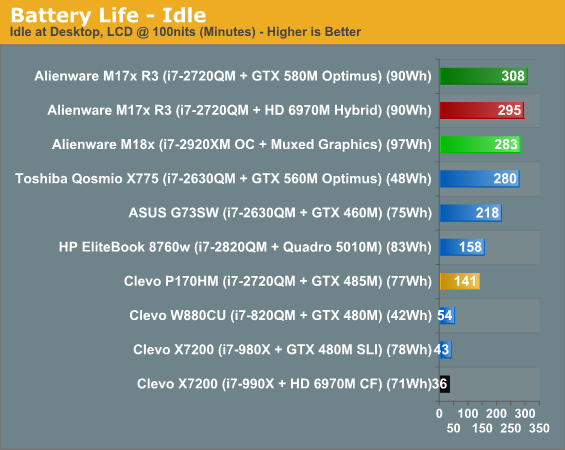
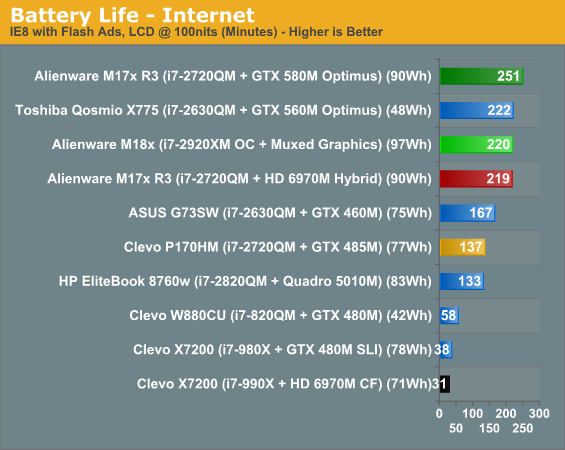
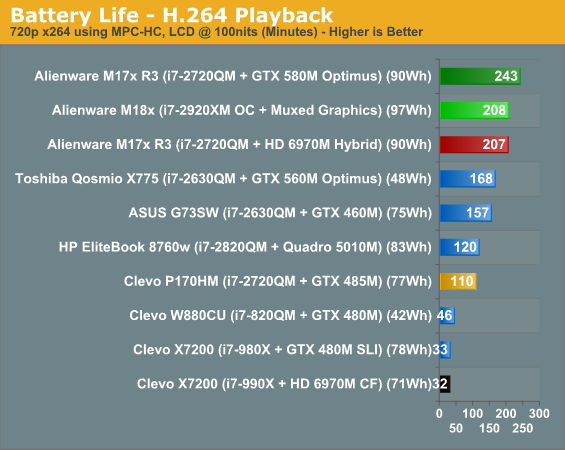
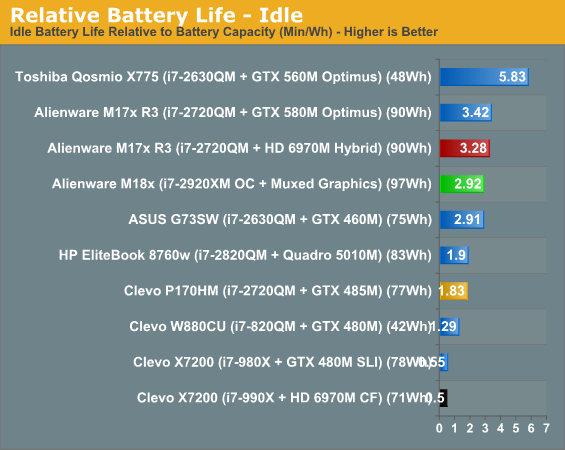
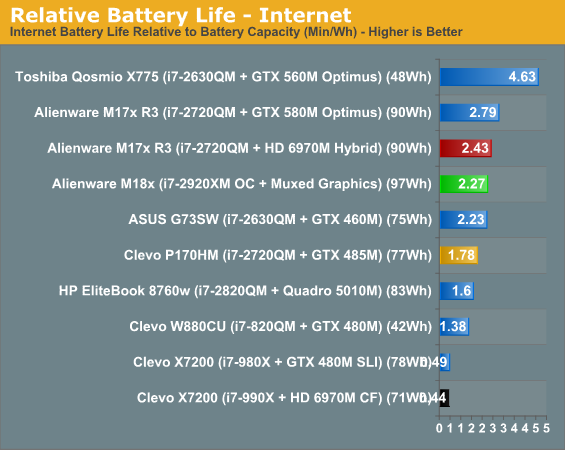
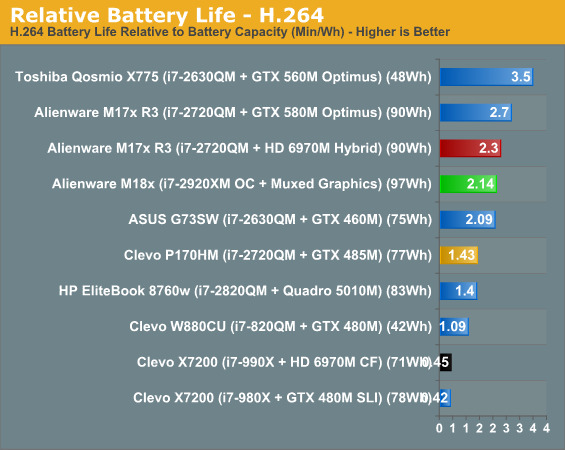
Optimus may still have some teething problems from time to time, but they're rare, and the benefits are undeniable. Meanwhile, the M18x's switchable graphics mean that despite being a 12 pound land monster, you can still take it to Starbucks and check up on your e-mail or watch a movie during a massive flight layover if you're so inclined. Of course, Toshiba's lighter Qosmio X775 winds up really stealing the show, offering nearly as much battery life on just half the battery.

We have our two sets of thermal results side-by-side, with the single GPU enabled on the left and SLI enabled on the right. You can see that having SLI enabled generates enough heat to push the overclocked i7-2920XM just a little bit too toasty, although the surface temperatures of the M18x remained relatively comfortable. Noise levels also increased noticeably in SLI mode, commensurate with the second GPU pulling its weight and thus increasing substantially the amount of heat being generated. Component temperatures remain reasonably low outside of the CPU getting such a good workout, and actually the M18x does keep these two high-end GPUs remarkably cool. End users may want to back down ever so slightly on the overclock.
Subjectively (sorry, my equipment and location isn't good for testing noise levels), the M18x still feels quieter than the Clevo X7200, but an M17x R3 under load is quieter still. Alienware's cooling system in the M18x is remarkably efficient given how much heat it has to remove.










32 Comments
View All Comments
rsandoz - Monday, October 3, 2011 - link
What about the case?I believe the m17xr3 is plastic.
The m18x has an aluminum case. I actually own this with 6790 CF. This one was of the deciding factors as I have own the m17xr1 and m17xr2. When I saw the r3 had a plastic case much like my m11xr1 with cracking hinge problem, I decided against it. Didn't want to talke a change on cracking hinges again. Probably not the case, but an aluminum case feels much more solid.
rsandoz - Monday, October 3, 2011 - link
<<Wish I could edit posts. Spell corrected.>>What about the case?
I believe the m17xr3 is plastic.
The m18x has an aluminum case. I actually own one with 6790 CF. This one was of the deciding factors as I have owned the m17xr1 and m17xr2. When I saw the r3 had a plastic case much like my m11xr1 with cracking hinge problem, I decided against it. Didn't want to take a chance on cracking hinges again. Probably not the case, but an aluminum case feels much more solid.
Dustin Sklavos - Monday, October 3, 2011 - link
The M18x's case only has an aluminum plate on the lid and aluminum trim, at least as far as I can tell. I honestly didn't find the build quality to be radically different enough from the M17x R3 to merit mentioning.rsandoz - Tuesday, October 4, 2011 - link
My main cause for concern was the "after 6 or so months factor". Does the m17xr3 have a cracking hinge issue after 6 months. I had an m11xr1 and after 8 months the hinges cracked internally. Felt like the ultimate hooptie laptop. Plus the plastic case has more scratches on it than my m17xr2.Death666Angel - Monday, October 3, 2011 - link
Seeing how this is pretty much a desktop in most terms, I would like to know what kind of PSU is shipped with the unit. Also, could you provide power consumption while gaming/stressing the system with the different setups? I'd be interested in the difference between the nVidia and AMD GPUs used here. :-)Otherwise, a good review and a monster of a laptop. Nothing for me though.
Ushio01 - Monday, October 3, 2011 - link
Buy the Core i7-2860QM instead it has same base clock with higher turbo boost and a 10W lower TDP for $500 less.JarredWalton - Monday, October 3, 2011 - link
That doesn't make a review "meaningless". The TDP is simply maximum power; in most loads you won't hit that level. As for saving $500, sure, go for it, but remember you'd also give up overclocking of the CPU. If you're already willing to spend around $3500 for this sort of notebook, what's another $500 to boost CPU speeds from 2.5GHz base and 3.6GHz max to 3.5GHz base and 4.2GHz max. With GTX 580M SLI, you'll probably actually realize a performance improvement from the CPU overclock in games.Ushio01 - Monday, October 3, 2011 - link
Sorry I never meant the review was worthless in itself just the out of date CPU.JarredWalton - Monday, October 3, 2011 - link
Understood, but I'm pointing out that the overclockable CPU might be worth the upgrade price, at least if you're willing to spend this much in the first place (I'm not). The i7-2860QM has the same base clock, but unfortunately the laptop Alienware sent is using the earlier i7-2920XM instead of the newer i7-2960XM. Either way, the XM model CPUs will get you unlocked multipliers and the ~$500 28x0QM chips won't.aznofazns - Monday, October 3, 2011 - link
I'm not sure you'd run into any significant CPU bottlenecks with a stock i7-2860M, though.The argument that the $3500 already spent justifies the additional $500 for the unlocked multiplier doesn't really make sense. The $3500 is a sunk cost. It's already gone and shouldn't affect the decision to spend more on the CPU.
The real question is... what is the marginal benefit of the 2920XM over the 2860M? Would you really be seeing significantly higher framerates? I'd say probably not. The dual GTX580M's in SLI would still be the bottleneck for gaming at 1080p, unless I'm mistaken.